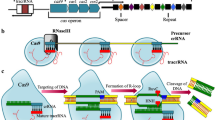Abstract
Transposable elements are the main components of grass genomes, especially in Triticeae species. In a previous analysis, we identified a very short element, Morgane_CR626934-1; here we describe more precisely this unusual element. Morgane_CR626934-1 shows high sequence identity (until 98%) with ESTs belonging to other possible small elements, expressed under abiotic and biotic stress conditions. No putative functional polyprotein could be identified in all of these different Morgane-like sequences. Moreover, elements from the Morgane_CR626934-1 subfamily are found only in wheats and Agropyrum genomes and among these species, only Ae. tauschii and T. aestivum present a high copy number of these elements. They are highly conserved in wheat genomes (95.5%). Based on the uncommon characteristics of the described Morgane-like elements, we proposed to classify them in a new group within the Class I LTR retrotransposon, the Morgane group.
Similar content being viewed by others
Abbreviations
- EST:
-
Expressed Sequence Tag
- LTR:
-
Long Terminal Repeat
- TE:
-
Transposable Element
- TRIM:
-
Terminal Repeats in Miniature
- LARD:
-
LArge Retrotransposon Derivative
References
Bendich AJ, McCarthy BJ (1970) DNA comparisons among barley, oats, rye, and wheat. Genetics 65:545–565
Bennett MD, Leitch IJ (1995) Nuclear DNA amounts in angiosperms. Ann Bot 76:113–176
Bennetzen JL, Ma J, Devos KM (2005) Mechanisms of recent genome size variation in flowering plants. Ann Bot 95:127–132
Chantret N, Cenci A, Sabot F, Anderson O, Dubcovsky J (2004) Sequencing of the Triticum monococcum Hardness locus reveals good microcolinearity with rice. Mol Genet and Genomics 271:377–386
Chantret N, Salse J, Sabot F, Rahman S, Bellec A, Laubin B, Dubois I, Sourdille P, Joudrier P, Gautier M-F, Cattolico L, Beckert M, Aubourg S, Weissenbach J, Caboche M, Bernard M, Leroy P, Chalhoub B (2005) Molecular basis of evolutionary events that shaped the Hardness, Ha. locus in diploid and polyploidy wheat species, Triticum and Aegilops. Plant Cell 17:1033–1045
Flavell RB, Rimpau J, Smith DB (1977) Repeated sequence DNA relationship in four cereals genomes. Chromosoma 63:205–222
Higgins D, Thompson J, Gibson TJ (1994) CLUSTALW: improving the sensitivity of progressive multiple sequence alignment through sequence weighting, position-specific gap penalties and weight matrix choice. Nucleic Acids Res 22:4673–4680
Huang X, Miller W (1991) A Time-efficient, linear-space local similarity algorithm. Adv Appl Math 12:337–357
Jurka J (1998) Repeats in genomic DNA: mining and meaning. Curr Opin Struct Biol 8:333–337
Kalendar R, Vicient CM, Peleg O, Anamthawat-Jonsson K, Bolshoy A, Schulman AH (2004) LArge Retrotransposon Derivatives: Abundant, conserved but non-autonomous retroelements of Barley and related genomes. Genetics 166:1437–1450
Keller B, Feuillet C (2000) Colinearity and gene density in grass genomes. Trends Plant Sci 5:246–251
Kumar A, Bennetzen JL (1999) Plant retrotransposons. Annu Rev Genet 33:479–532
Levy AA, Feldman M (2002) The impact of polyploidy on grass genome evolution. Plant Physiol 130:1587–1593
McCarthy EM, McDonald JF (2003) LTR_STRUC: a novel search and identification program for LTR retrotransposons. Bioinformatics 19:362–367
Melayah D, Bonnivard E, Chalhoub B, Audeon C, Grandbastien M-A (2001) The mobility of the tobacco Tnt1 retrotransposon correlates with its transcriptional activation by fungal factors. Plant J 28:159–168
Mhiri C, Morel JB, Vernhettes S, Casacuberta JM, Lucas H, Grandbastien M-A (1997) The promoter of the tobacco Tnt1 retrotransposon is induced by wounding and by abiotic stress. Plant Mol Biol 33:257–266
Murigneux A, Barloy D, Leroy P, Beckert M (1993) Molecular and␣morphological evaluation of doubled haploid lines in maize. 1 – Homogeneity within DH lines. Theor Appl Genet 86:837–842
Sabot F., Guyot R., Wicker T., Chantret N., Salse J., Laubin B., Leroy P., Sourdille P, Chalhoub B, Bernard M (2005a) Updating transposable elements annotations from large wheat genomic sequences reveals diverse activities and gene association of elements. Mol Genet Genomics 274:119–132
Sabot F, Sourdille P, Bernard M (2005b) Advent of a new retrotransposon structure: the long form of the Veju elements. Genetica 125:325–335
Sabot F, Simon D, Bernard M (2004) Plant transposable elements, with an emphasis on grass species. Euphytica 137:227–247
Sambrook J, Russel A (2001) Molecular cloning a laboratory manual. Cold Spring Harbor: Laboratory Press, Cold Spring Harbor, New York
Takeda S, Sugimoto K, Otsuki H, Hirochika H (1998) Transcriptional activation of the tobacco retrotransposon Tto1 by wounding and methyljasmonate. Plant Mol Biol 36: 365–376
Wicker T, Stein N, Albar L, Feuillet C, Schlagenhauf E, Keller B (2001) Analysis of a 211 kb sequence in diploid wheat, Triticum monococcum L. reveals multiple mechanisms of genome evolution. Plant J 26: 307–316
Wicker T, Matthews DE, Keller B (2002) TREP: a database for Triticeae repetitive elements. Trends Plant Sci 7:561–562
Witte C-P, Le QH, Bureau TE, Kumar A (2001) Terminal-repeat retrotransposons in miniature, TRIM. are involved in restructuring plant genomes. Proc Natl Acad Sci USA 98:13778–13783
Author information
Authors and Affiliations
Corresponding author
Electronic supplementary material
Rights and permissions
About this article
Cite this article
Sabot, F., Sourdille, P., Chantret, N. et al. Morgane, a new LTR retrotransposon group, and its subfamilies in wheats. Genetica 128, 439–447 (2006). https://doi.org/10.1007/s10709-006-7725-5
Received:
Accepted:
Issue Date:
DOI: https://doi.org/10.1007/s10709-006-7725-5




